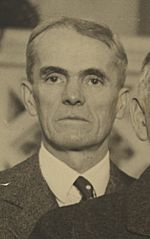Walter Sydney Adams facts for kids
Quick facts for kids
Walter Sydney Adams
|
|
|---|---|

Walter Sydney Adams
|
|
| Born | December 20, 1876 |
| Died | May 11, 1956 (aged 79) |
| Nationality | United States |
| Alma mater | Dartmouth College University of Chicago |
| Awards |
|
| Scientific career | |
| Fields | Astronomy |
| Institutions | Mount Wilson Observatory Yerkes Observatory |
Walter Sydney Adams (December 20, 1876 – May 11, 1956) was an American astronomer. He was known for his important work studying the light from stars.
Contents
Life and Discoveries
Walter Sydney Adams was born in Antioch, Turkey. His parents were missionaries. In 1885, his family moved to the U.S..
Early Life and Education
Walter went to Dartmouth College and graduated in 1898. He then continued his studies in Chicago and Germany. After finishing his education, he returned to the U.S. and began his career in Astronomy. He eventually became the director of the famous Mount Wilson Observatory.
Studying Starlight
Walter Adams was very interested in stellar spectra. This means he studied the light that comes from stars. When starlight is split, it creates a rainbow-like pattern called a spectrum. This spectrum can tell scientists a lot about a star.
He worked on studying the Sun's spectrum. He helped discover a way to tell how bright a star truly is (its absolute magnitude). He found that the brightness of certain lines in a star's spectrum could show if it was a huge giant star or a smaller dwarf star.
Discovering White Dwarfs
In 1915, Adams began studying the companion star to Sirius. This star is called Sirius B. He found that even though Sirius B was only a little bigger than Earth, its surface was much brighter than the Sun's. He also found it was very heavy, almost as heavy as the Sun.
Stars like Sirius B are now known as white dwarfs. They are very dense, meaning they pack a lot of mass into a small space.
Other Discoveries
Walter Adams also worked with another scientist, Theodore Dunham. They found a lot of carbon dioxide in the atmosphere of Venus. They saw this by looking at the infrared light coming from the planet.
Walter Adams passed away in Pasadena, California, when he was 79 years old.
Awards and Recognition
Walter Sydney Adams received many important awards for his work in astronomy.
Major Awards
- Gold Medal of the Royal Astronomical Society (1917)
- Henry Draper Medal from the National Academy of Sciences (1918)
- Fellow of the American Academy of Arts and Sciences (1922)
- Valz Prize from the French Academy of Sciences (1923)
- Bruce Medal (1928)
- Janssen Medal from the French Academy of Sciences (1934)
- Foreign Member of the Royal Society (ForMemRS) (1950)
- Henry Norris Russell Lectureship (1947)
Named in His Honor
- An asteroid was named after him: 3145 Walter Adams.
- A crater on Mars is named after him.
- The crater Adams on the Moon is named for him and two other astronomers with the last name Adams.
See also
 In Spanish: Walter Sydney Adams para niños
In Spanish: Walter Sydney Adams para niños

